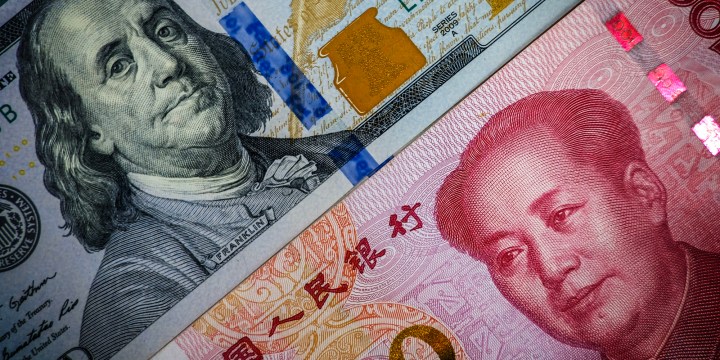GLOBAL ECONOMY OP-ED
US-China trade decoupling seems all but assured – and the costs are mounting

Latest research shows the US and China’s pursuit of economic independence, resulting in the process of decoupling and trade policy uncertainty, is already costing the global economy. Though the road back to a healthy trade environment that has served us well in the past is clear, the evidence suggests that the horse has already bolted.
Three years ago, it looked like China was flying, managing to keep Covid infections under better control than anywhere else, and overseeing an economy that still seemed to be on the boil. Today, however, the world’s second-largest economy has the dubious pleasure of experiencing the most economic headwinds of all the other economic giants.
During 2019, Chinese GDP came in at 6.1%, not too far off its 7% target rate, and more than double world growth of 2.9%. In 2022, however, though the government downgraded its targeted growth rate to 5.5%, it still looks far out of reach after second-quarter Chinese growth came in at 3.9%.
China’s economic challenges range from a property sector that is on its knees, a Covid zero approach that government shows no signs of easing, and investors largely turning their backs on a government and financial market that has moved further and further away from capitalism – and towards a strictly China-first managed economy by Xi Jinping and now his merry band of loyalists.
Geopolitically and economically, the two world powerhouses, the US and China, look to be moving further apart, raising the prospect of a decoupling and divided West versus East world.
The rift arguably began in earnest during Donald Trump’s time as US president when he set in motion a trade war that is already having real and profound ramifications for world trade.
Recent in-depth research conducted by the Peterson Institute for International Economics (PIIE) details the impact Trump’s various tariffs – and tariff changes – have had on trade flows between the US and China, and where the shifts have occurred.
Titled “Four years into the trade war, are the US and China decoupling?”, the research finds that US imports of Chinese products that are subject to the higher tariffs, namely 25%, have contracted sharply over the last four years, while imports of products that are subject to much lower or no tariffs are higher than ever.
The report identifies the products that have fallen dramatically, including semiconductors, some IT hardware and consumer electronics. Clothing, footwear and furniture imports have also declined.
Meanwhile, US imports that are higher than ever include laptops and computer monitors, phones, video game consoles and toys.
The hardest-hit imports subject to a 25% duty have declined 22% below pre-trade levels, versus a 34% increase in these products from the rest of the world. And imports of products not subject to trade war tariffs have grown 50% over the same period.
In all, PIIE data show that the trade war has resulted in the US now sourcing 18% of its goods imports from China versus the 22% when the trade war began. In contrast, US imports from the rest of the world have increased by 38% compared with pre-trade war levels.
The author of the report, PIIE senior fellow Chad Bown, says: “US and Chinese policymakers certainly seem determined to reduce the two countries economic interdependence, built over many decades but now buckling under the weight of their animosities.
“So far, the decoupling that is – and is not – occurring is partly the result of Donald Trump’s trade war, the selective way it was waged, and the continuation of many of those policies under the Biden administration.”
Decoupling is expected to impose immediate costs that include product shortages as a result of supply chain adjustments and inflation as companies pass on the cost of finding new suppliers, with firms and consumers bearing the ultimate price in an environment when inflation is already at four-decade highs.
Visit Daily Maverick’s home page for more news, analysis and investigations
The primary reason policymakers are reducing their economic interdependence is because of the perceived long-term benefits of onshoring the production of strategic goods to maintain control over their production and supply.
In the US, acting against China’s human rights abuses and other abuses of economic power is another strong motivating factor.
However, they will have to weigh up the rising costs that are likely to arise out of reducing trade ties with the additional costs it will introduce to the domestic economy – a stance that is directly in conflict with the current US monetary policy agenda, which is to bring down inflation at whatever the cost to the economy.
Bown’s bottom line is: “Policy decisions made today to reduce economic interdependence between the two countries will have profound implications for both economies, and neither will escape unscathed.”
The IMF explores the potential impact of harmful trade fragmentation even further to encompass the whole of Asia as a region, in a blog titled, Asia and the World Face Growing Risks From Economic Fragmentation. It points out that about half of the imports in the US, and a third in Europe, come from Asia and that Asian countries are the source of half of the global demand for key commodities.
With geopolitical tension on the rise, it says that “strategic competition and national security concerns may trump the shared economic benefits of global trade” and that the results of fragmentation could be very costly.
The costs have already begun to mount, with the IMF noting that trade policy uncertainty in the build-up to US-China tensions in 2018 had reduced investment by about 3.5% over the following two years.
It estimates that this decreased GDP by 0.4% in Asia and increased the unemployment rate by 1 percentage point.
Based on its research, the IMF advises policymakers to:
- Roll back damaging trade restrictions and reduce trade policy uncertainty.
- Complement regional agreements with reforms at the multilateral level.
- Restore a fully functional World Trade Organization dispute settlement system.
These steps, it says, could “not only mitigate potential negative impacts of discriminatory policies on other trading partners, but also help resolve some of the underlying sources of tensions”.
The wish list may be well intended and does make complete sense, based on the many decades during which the world economy has flourished because all these conditions were satisfied.
However, the odds are overwhelmingly in favour of these being unachievable within the current global context.
Instead, we can almost certainly look towards a global trade environment that is significantly more complex, costly, divided and self-serving. BM/DM



















Comments - Please login in order to comment.